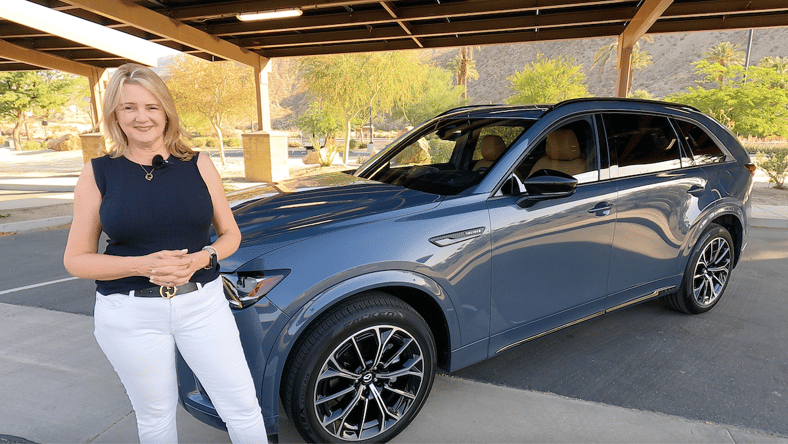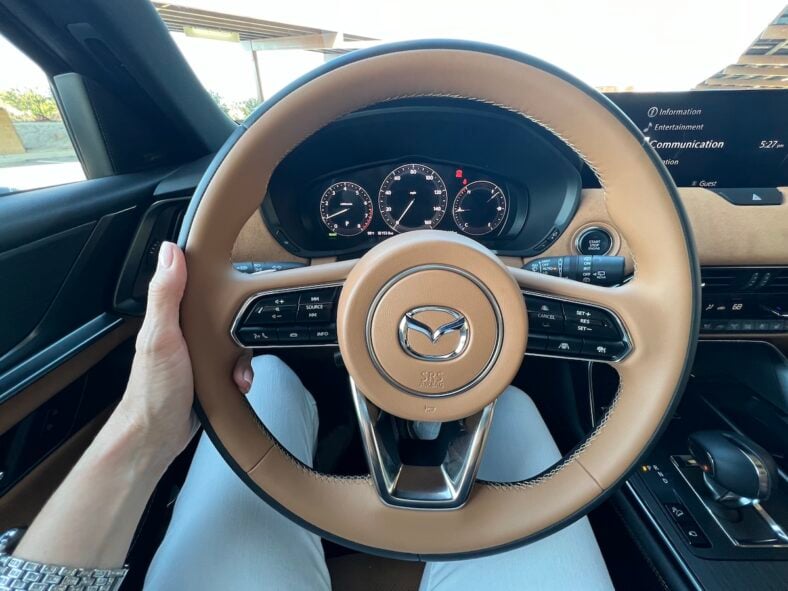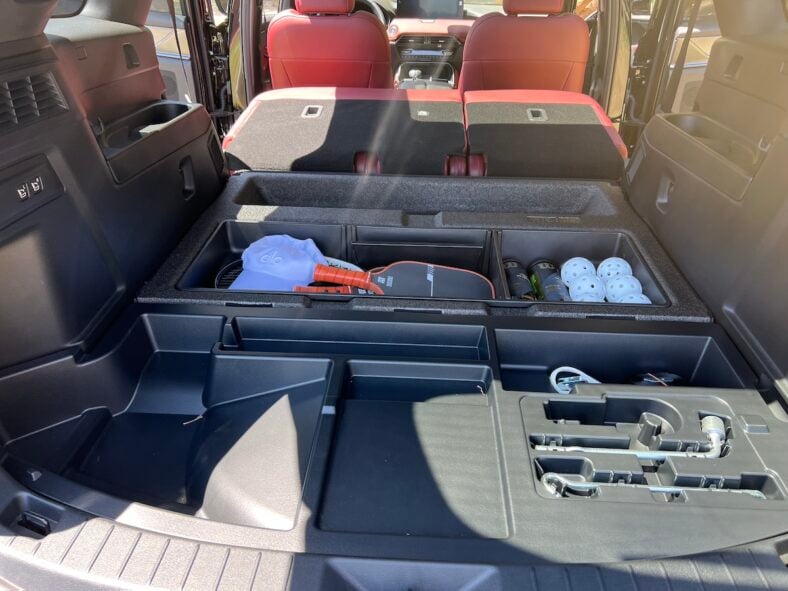The 2025 Mazda CX-70 Is A More Refined CX-90 That Skips the 3rd Row
If you want a full size SUV but don't need a 3rd row, should you be forced to buy one? The Mazda CX-70 thinks not. This premium sibling to the CX-90 skips the extra seating for more luxe features.

A Large SUV, But Without the Baggage Extra Seating
True story: A friend traded her 3-row SUV for a 2-row, 5-passenger SUV because she no longer wanted to be a part of carpool duty. And I get it. Her kids were a little older; one could sit up front, and she didn’t need the 3rd row anymore. She could trade the space of the 3rd row for more room and focus on family weekends rather than group sports. Had she been able to trade from a Mazda CX-90 to the Mazda CX-70, she would have been very happy. The CX-70 is a full-sized 5-passenger SUV that puts the focus on front and rear seat passengers, cargo space, and refined features. But without a 3rd row. See our full video on the Mazda CX-70 here.
Related: Goodbye, Mazda CX-9, Hello Mazda CX-90: Bigger, Better and More Luxurious

The Mazda CX-70: What This Car Is All About
The CX-70 is essentially the CX-90 without the 3rd row, plus a few additions:
- The narrowed-down trim lineup is a bit more premium, with a higher starting price and more luxury details
- 5 models are powered by an inline 6-cylinder turbo engine with a mild hybrid system that boosts power and performance with a small electric motor, noted by the “e-Skyactive G” badge on the rear liftgate
- There are 3 versions—Turbo, Turbo S, and PHEV—and pricing starts at about $40K, a bit more than the CX-90, which offers more family-friendly features, including a lower entry-level price
- There is slightly more cargo space and some nice under-floor storage
I spent half a day driving the Turbo S and then half a day driving the PHEV plug-in hybrid version and both just like the CX-90, are very nice, with solid performance and details that refine the experience. And I can appreciate the fact that the absence of a 3rd row is just as attractive as the addition of one: You get to pick the car that fits you best rather than making a compromise because it’s the best you can do.
Related: Infiniti QX50 Review: This Luxury SUV is Filled with Bright Springtime Feels

Who The Mazda CX-70 is For
- Drivers who need a sizable cargo space and appreciate smart storage under the cargo floor
- Small families or singles who don’t need a 3rd row
- Fur families who need room for a dog crate in the cargo area
- Buyers who just like a full-size SUV
- Drivers who need all-wheel drive and tow capacity; this SUV can tow up to 5,000 lbs.
- Buyers who love the power and style of Mazda
Related: Luxury On the Inside, Rugged on the Outside, The 2022 Jeep Grand Cherokee

Three Engine Types to Choose From
The Mazda CX-70 comes in 3 engine types and two or three trims per type. There are two turbo lines and one plug-in electric hybrid. Keep in mind that Mazda’s turbo engines can use either premium or regular gas, but in order to get the horsepower quoted here, which Mazda touts, premium is required. Using regular octane gas is fine, but you’ll get about 25 HP less than the numbers here (and, if you ask me, you won’t feel the difference unless you do a lot of performance driving and are really sensitive to power levels).
Here’s how they break down:
The 6-cylinder models have a mild hybrid system that uses a large battery to operate a small electric motor to boost performance and fuel economy. They offer two power levels, both estimated to get about 25 MPG:
- Turbo, which generates 280 hp, comes in Preferred ($40,445), Premium ($45,900), and Premium + ($48,900) trims;
- Turbo S, which generates 340 hp, comes in Premium ($52,450) and Turbo S Premium + ($55,950)
Then, the Plug-in Hybrid Electric Vehicle, or PHEV, has a 17 kWh battery that generates 323 HP and delivers an all-electric range of about 39 miles. There are two choices: PHEV Premium ($54,400) and PHEV Premium + ($57,450)
Related: The 11 Best Luxury SUV Interiors on a Budget

Driving the Turbo S
The first day of my test drive I spent the afternoon in a Turbo S model, a nicely appointed, leather-upholstered model, and was reminded of all the things to like about the CX-90: the multimedia system that is dial controlled, the elegant wood and aluminum trim, the ‘zen’ of Mazda’s nicely edited interiors.
The Turbo S has three drive modes: Sport, Normal, and Off-Road which lets you put the standard AWD to work when you need it.

Driving the PHEV
On the second day, I challenged the PHEV to see how far I could drive on electric power. And it was nice. I started out with 39 miles of range, which I could see by clicking “information” on the multimedia screen and then looking at the battery details. From there, I selected EV mode in the drive mode menu; the driver display glowed in blue and away I went in lovely silence.
I headed out for my morning ritual of a Starbucks stop for a latte and to see how this large SUV handled in a tight parking lot. It was great. Not only does it handle more like a car than a truck on the highway and local roads, but it was easy to park. I really appreciated the surround-view camera that allowed me to see all sides of the car, and the forward camera that shows you what you don’t see from the driver’s seat.
I picked up my coffee, restarted the car, and went on my way, soon realizing that I was no longer in EV mode; I selected it on the drive selector again. Once I did I was easily back in EV mode.
In all, the system seemed to work as expected, giving me about the number of electric miles it reported on the range when I started. Of course it’s what you expect, but not always what you get.
I headed up the Palms to Pines highway and soon depleted the electric range. At that point, the hybrid engine kicked in with all the power I needed to climb the hills. It was still quiet, though not as quiet as the electric system, but it was also powerful, giving me confidence through the twisty turns and steep rise of the highway. And it was fun.

How Kids Car Seats Fit
Of course this car is perfect for those who don’t need multiple car seats, but it’s also ideal for families who have 3 kids in car seats and want them all within arms reach on a rear bench seat. And, because all the seats will be filled with car seats, a 3rd row is pretty useless.
The CX-70 could be ideal. First, the Mazda CX-70’s rear seats are adjustable forward and back; you can slide them forward so they are closer to the front seat or adjust them for more leg room.
Then, they should fit 3 car seats across the bench. I measured the rear seats and found the outboard seats are 19” wide and the middle seat is about 12” wide, meaning three car seats should easily fit across the bench.
Measuring seat back to seat back, with the front seat set for my driving position (I’m 5’8”) I measured 32.5.” That is more than enough room for a rear-facing child car seat. It’s likely that if the driver isn’t taller than 6’, a second rear-facing car seat would fit behind the driver as well. And, a slim seat will fit in the middle seat. Good news for families with two or three kids in car seats.

Why Buy This and Not That?
The Mazda CX-90 is a winner for certain. The interior details are thoughtful, the materials are beautiful and the overall feeling is very premium. But in the CX-70 it gets just a bit better for buyers who want more refinement in the absence of that one thing that tilts the car toward family: a 3rd row.
Even so, it’s still great for families who only want the rear seat or for rear passengers who want to stretch out. There’s a large space for the pups to rest (or to haul a dog crate), and there’s plenty of cargo space for your bags and hide-away things.
Which is what makes it so nice: you can have your large SUV and not be pigeonholed into something that car carpool. It’s the power, and delight, of being able to say ‘No.’
Disclosure: I was a guest of Mazda for this test drive. Travel and accommodations were provided but all opinions are my own.
More About:Car Reviews
